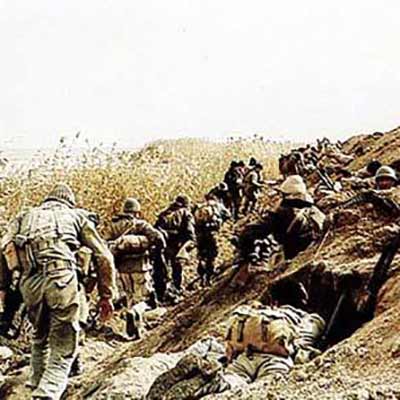Battles
Operation Quds 5
Maryam Akhoundian
163 Views
Operation Quds 5 was the last of a series of small-scale operations carried out by the 25th Karbala Division of the Islamic Revolutionary Guard Corps (IRGC) on August 6, 1985, in Hur al-Hoveyzeh, north of the Badr operational area (Khuzestan). This operation led to the liberation of 30 square kilometers of Iranian territory.
The targeted area in Operation Quds 5 was Hur al-Hoveyzeh, north of the Badr operational region, between Bilal Outpost and Khandaq Road, east of al-Bayza.[1] In operations Quds 1 and Quds 2, the 25th Karbala Division had managed to seize several amphibious enemy outposts, getting closer to Alij Outpost and al-Bayza (Khuzestan). On July 6, 1985, the Intelligence and Operations Unit of al-Ghadir Brigade of Yazd started doing reconnaissance in the Hazrat Rasool (pbuh) Waterway to the right of Alij Outpost and Hamza Seyyed al-Shuhada Waterway along Tabuk Waterway.[2]
The operation aimed at capturing Alij Outpost, advancing towards al-Bayza, providing the security of Khandaq Road and the right flank of the defensive line, improving defensive capabilities, narrowing the area covered by the defense system, and reducing the number of water-based outposts.[3]
In this operation, the Badr Brigade employed the Jundallah Company, Hurr Company, and special combat divers as part of the Imam Ali (as) Battalion.[4]
The enemy’s defensive line consisted of a series of outposts that were used for carrying out ambushes and protected the Alij Outpost as their central headquarters. The tactical headquarters of the central command of the company serving in that area was located 700 meters from Alij Outpost and one kilometer from al-Bayza as its main headquarters.
Enemy assets in Alij Outpost included two single-barrel anti-aircraft guns, two 81 mm and 82 mm mortars, enough ammunition for 48 hours of intense conflict, and the 3rd Battalion of the 701st Huzayfa Commando Brigade. According to final reconnaissance reports, the enemy had increased the amount of ammunition at Alij Outpost and stocked more explosive barrels.
The Iraqis had made several obstacles, including seven rows of barbed wire near their outposts, around seven hundred meters of minefields, thirty 200-liter drums, and twenty-eight 200-liter containers filled with materials that emit flammable gases when water reaches their sodium fuse.[5]
The estimated time to reach the enemy’s defensive line was two hours via the Hazrat Rasool (pbuh) and Hamza Seyyed al-Shuhada axes and three hours via the Imam Ali (as) axis. Accordingly, the Salman Headquarters scheduled the engagement and the start of the operation for 9 PM on August 6, 1985.[6]
The forces began moving towards the enemy between 6 and 7 PM. Due to the longer distance, troops positioned on the Imam Ali (as) axis began their movement at 6 PM, while forces on the Hazrat Rasool (pbuh) and Hamza Seyyed al-Shuhada axes entered the waterways at 9 PM. The Iranian forces moving through the shorter routes bypassed friendly outposts and reached enemy lines. However, the ones on Imam Ali (as) axes did not signal their readiness on time. In the meantime, the Iraqis were firing aimlessly in all directions.
Finally, at 11 PM, the forces positioned on the last axis declared their readiness, and with the code-name “Ya Ali (as), help us”, the operation began.
In coordination with the divers, the troops running the boats successfully captured Alij Outpost and took 18 as war prisoners after having a 30-minute clash with the enemy. Overall, the brigade forces not only seized Alij Outpost but also cleared ambush points and outposts up to 1.5 kilometers from al-Bayza. Furthermore, they established barriers and created ambush spots in the main waterway, two kilometers from al-Bayza.[7]
The liberated areas were fully stabilized within three days, and finally, about 30 square kilometers of Hur al-Hoveyzeh came under Iranian control. Enemy casualties included 51 killed and 18 captured. In addition, various weapons, including two 60 mm and 81 mm mortars and two single-barrel anti-aircraft guns, were seized.[8]
In this operation, 38 Iranians were martyred, and 60 were wounded. Also, several boats were destroyed or damaged due to shrapnel.[9]
On August 7th, the correspondent for the Iraqi news agency in eastern Tigris denied the execution of Operation Quds 5. He emphasized in a press conference that no clashes had occurred on that front during the past two days. Likewise, the Israeli radio reported on Operation Quds 5: “The Islamic government of Iran has announced that its forces have launched a new attack in Hur al-Hoveyzeh against the Iraqi army, capturing 50 square kilometers of the northern part of that area.”[10]
Two days after the operation, the War Propagation Headquarters invited a group of journalists from Germany, the United States, Belgium, Japan, Syria, the Netherlands, and Australia to visit the liberated areas in Hur al-Hoveyzeh. They documented reports and footage of the freed zones, destroyed enemy equipment, and enemy casualties. On the same day, the Supreme Defense Council held a meeting to discuss Operation Quds 5.[11]
[1] Selsele-ye Amaliyat-e Quds (The Phases of Operation Quds), Tehran: Markaz-e Motaleat va Tahqiqat-e Jang-e Sepah-e Pasdaran-e Enghelab-e Eslami, 2005, p. 80.
[2] Ibid., p. 81; Khastar, Ahmad, Nabard-e Elitch (The Battle of Elitch), Tehran: Sarir, 2006, Pp 16, 21–22; Habibi, Abolqasem, Atlas-e Khuzestan dar Jang-e Iran va Araq (Atlas of Khuzestan in the Iran-Iraq War), Tehran: Markaz-e Asnad va Tahqiqat-e Defa-e Muqaddas, 2014, p. 201.
[3] Selsele-ye Amaliyat-e Quds (The Phases of Operation Quds), p. 83.
[4] Ibid.; Habibi, Abolqasem, Atlas-e Khuzestan dar Jang-e Iran va Araq (Atlas of Khuzestan in the Iran-Iraq War), p. 174.
[5] Selsele-ye Amaliyat-e Quds (The Phases of Operation Quds), Pp. 81–82.
[6] Ibid., p. 84.
[7] Nakhaei, Hadi, Mashhadi Farahani, Hamidreza, Rouzshomar-e Jang-e Iran va Araq (Chronology of the Iran-Iraq War), Book 37, Tehran: Markaz-e Motaleat va Tahqiqat-e Jang-e Sepah-e Pasdaran-e Enghelab-e Eslami, 2004, Pp. 625–626.
[8] Ibid., p. 626.
[9] Selsele-ye Amaliyat-e Quds (The Phases of Operation Quds), p. 87.
[10] Nakhaei, Hadi, Mashhadi Farahani, Hamidreza, Rouzshomar-e Jang-e Iran va Araq (Chronology of the Iran-Iraq War), Book 37, p. 643.
[11] Ibid., p. 650.





